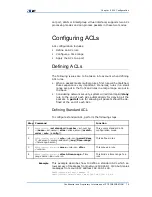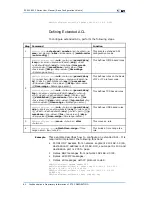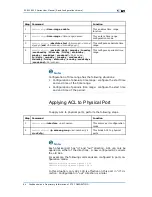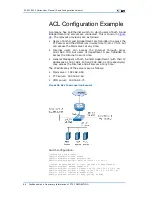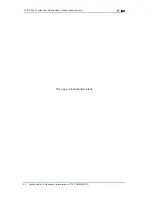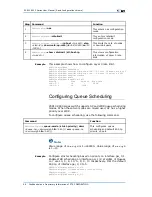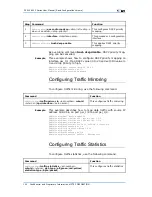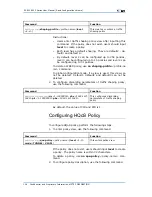
Chapter 10 QoS Configuration
It assumes that packets are colorless in color-blind mode but as-
sumes that packets are marked in a color in color-aware mode.
A color is assigned to each packet passing through the switch ac-
cording to a certain principle (packet information) on the switch.
The Maker renders IP packets in the DS domain according to re-
sults given by the Meter.
Algorithm of the above two markers are described in details below.
SrTCM
This algorithm is used in the Diffserv traffic conditioner to mea-
sure information flow and mark packets according to three traffic
parameters (Committed Information Rate (
CIR
), Committed Burst
Size (
CBS
) and Excess Burst Size
EBS
)). These parameters are
called green, yellow and red markers. A packet is green if its size
is less than CBS. A packet is yellow if its size is between CBS and
EBS and is red if its size exceeds EBS.
TrTCM
This algorithm is used in the Diffserv traffic conditioner to mea-
sure IP information flow and mark a packet in green, yellow or
red according to the Peak Information Rate (
PIR
) and Committed
Information Rate (CIR) and their relevant burst sizes (CBS and
PBS
). A packet is marked in red if its size exceeds PIR. A packet is
marked in yellow if its size is between PIR and CIR and is marked
in green if its size is less than CIR.
Traffic Shaping
Traffic shaping is used to control the rate of output packets thus
sending packets at even speed. Traffic shaping is used to match
packet rate with downlink equipment to avoid congestion and
packet discarding.
Traffic shaping is to cache packets whose rate exceeds the limited
value and send packets at even rate; while traffic monitoring is to
discard packets whose rate exceeds the limited value. Moreover,
traffic shaping makes delay longer but traffic monitoring does not
introduce any extra delay.
Traffic shaping is classified into the following two kinds:
�
Incoming port bandwidth traffic shaping
�
Outgoing port bandwidth traffic shaping
Queue Scheduling and Default
802.1p
Each physical port of the ZXR10 8900 series switch supports eight
output queues (queue 0 to queue 7) called CoS queues. Switch
performs incoming port output queue operation according to the
CoS
queue corresponding to 802.1p of packets. In network con-
gestion, the queue scheduling is generally used to solve the prob-
lem that multiple packets compete with each other for resources
at the same time.
Confidential and Proprietary Information of ZTE CORPORATION
93

